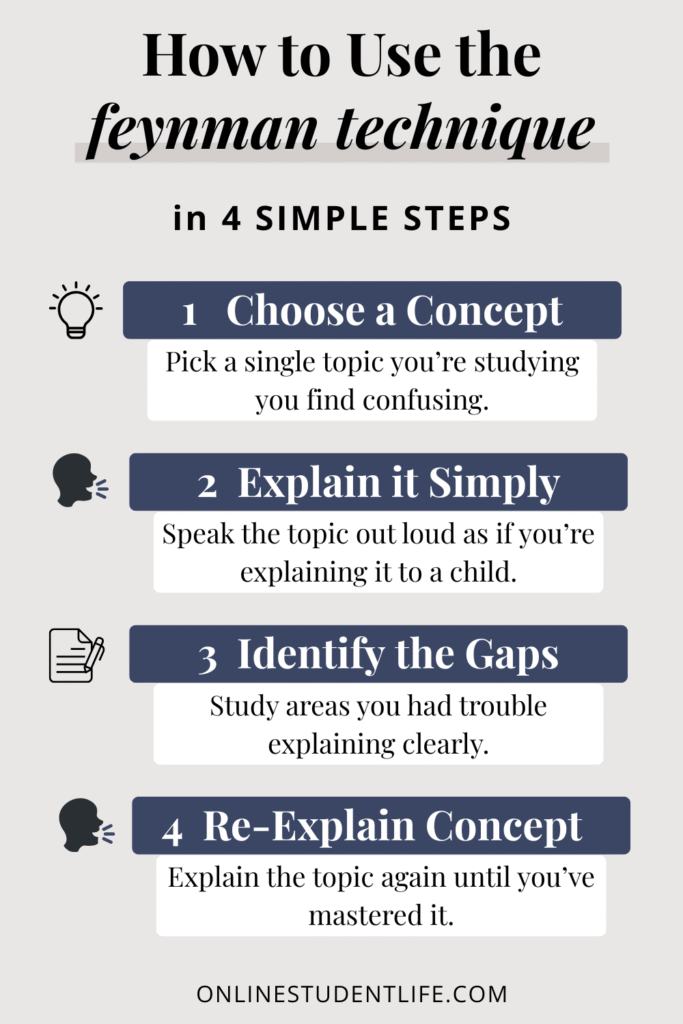I’ve spent countless hours reading my textbooks, reviewing pages and pages of notes and highlighting every word that felt important, but still walked away feeling like I didn’t actually get it.
I would show up to exams thinking I had prepared enough, only to realize I could recognize the material but couldn’t fully apply it. That’s when panic would set in and my exam confidence would crash.
As an online student, it’s especially important that we adopt strategies that help make the material stick. One disadvantage of online learning I’ve found is that most courses are taught by us reading independently (which is passive learning). Without in-person lectures or face-to-face study groups to lean on, we need to be more intentional with how we study.
That’s where using the Feynman Technique for studying comes in. It’s simple, effective, and honestly a bit enjoyable once you get the hang of it.
What is The Feynman Technique?
“It is said that if you can’t explain a concept in simple terms, you probably don’t really understand it yourself.”
– Alexandra Markin, founder of Online Student Life
The Feynman Technique is a 4-step study method in which you explain a concept in simple terms to someone who has no background knowledge in it. It works by promoting deep understanding and long-term retention of material, perfect for students in all levels of education.
It can be used for a wide range of topics especially at the college level, from how to solve complex math concepts (like finding the p-values in statistics) or what sampling means in market research.

The Feynman Technique is named after Richard Feynman, a 1965 Nobel Prize–winning American theoretical physicist who was known for making complex ideas sound simple. (Feynman in 1965. Photo credit: Wikipedia)
The Feynman Technique always makes me think of that scene from The Simpsons (“Much Apu About Nothing” – Season 7, Episode 23) where a parent visits an elementary school to explain their job to a class – and ends up confusing the kids so badly that one of them cries.
This is basically what happens to us when we try to study without really understanding: we can repeat the words, but we can’t explain them in simple terms. Therefore, it’s us students who end up feeling like crying.
The 4 Steps of The Feynman Technique for Studying
The Feynman Technique has 4 steps:
- Choose a concept you want to learn.
- Explain it simply in your own words.
- Identify the gaps where your understanding is weak.
- Re-explain in simpler terms.

Step 1 – Choose a Concept You Want to Learn
Pick a single topic you’re studying – something that’s confusing or you feel you need to understand more clearly.
Step 2 – Explain It Simply In Your Own Words
Once you think you have learned the material enough, try teaching the concept to someone else.
You can write down the explanation if you prefer it, but this technique works better if you actually speak the words.
However, as an online student I understand it may be impossible to have another person to explain it to. In this situation, and because I mostly study alone, I say the words out loud – to myself.
I felt so weird and embarrassed when I first started doing this, even though there was no one else in the house! But when I eventually got over talking to myself (or to thin air) it actually helped me organize my thoughts so the concept would sink in.
If you can’t get the point across in simple everyday language, have to repeat concept terminology or keep pausing because you keep drawing a blank, it’s a clear sign that you need to understand the topic more deeply.
The Feynman Technique makes sure you’re not just saying the words – but that you actually understand them.
Step 3 – Identify the Gaps in Your Understanding
What were the areas you had trouble explaining?
Go back to your textbook, notes or examples to study those areas. If you find you need more help, source reputable YouTube videos or reach out to your instructor or classmates.
Step 4 – Re-Explain in Simpler Terms
Re-write or re-explain the concept again when you feel you’ve reviewed the area you were weak in.
Repeat step 3 and 4 until you have mastered the concept and can explain simply with no difficulty.
The goal is to make it click, for you and anyone else listening.
How to Put The Feynman Technique Into Practice: Study Example
To demonstrate how the Feynman Technique worked for me as an online Bachelor of Commerce (Marketing) student, below I outline an example from when I took my Marketing Research course where we were learning the concept of market sampling.
Step 1 – Choose a Concept
Market sampling.
Textbook definition: the collection of data from a small group of people to learn about a larger market or customer base.
Step 2 – Explain It Simply
“Let’s say that because coffee is so popular among students, we want to know what roast college students prefer: light, medium or dark. We could ask every student in the United States, but that would be impossible.
Instead, we ask a smaller group of students and use their answers to guess what the whole group might think. That’s what market sampling means.
It saves time and money while still giving us useful insights, as long as we use the right kind of sample, like random sampling,…”
Step 3 – Identify the Gaps
I knew there were a few different types of sampling, yet I could only recall the random sample. Nor could I recall when each type of sample should be used.
So I went back and reviewed the textbook and added to my notes:
- Random sampling: everyone has an equal chance of being picked.
- Stratified sampling: divide people into groups first (like age or major).
- Convenience sampling: easiest to reach, but riskier for accuracy.
Step 4 – Re-Explain
“Market sampling saves both time and money, as long as we use the right kind of sample.
There is a random sample where every student has an equal chance of being picked, a stratified sample where we divide students into groups first (like age or major), or a convenience sample where it’s easy for us to find participants, like surveying the students who come into the on-campus cafe.”
Conclusion
Using the Feynman Technique helped raise my exam scores because I actually fully understood the concept, and didn’t even hesitate when it came to answering the question.
“The first principle is that you must not fool yourself and you are the easiest person to fool.”
– Richard P. Feynman
Ouch. That quote really hit home for me as a student. Thanks Feynman.
Have you tired the Feynman Technique for studying? Let me know in the comments below how it worked for you!
If you found this post helpful, sign up for my email list below and follow me on Instagram and Pinterest to join our online student community – you don’t have to go through your study journey alone!




